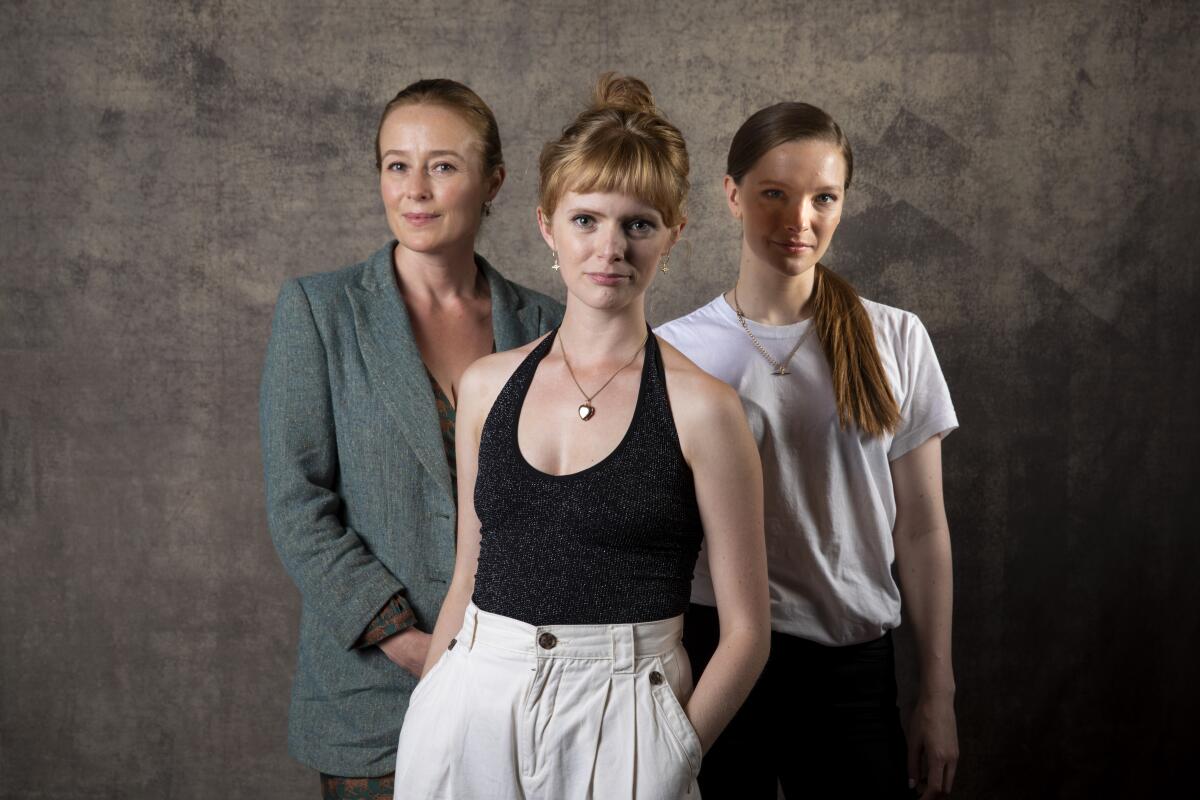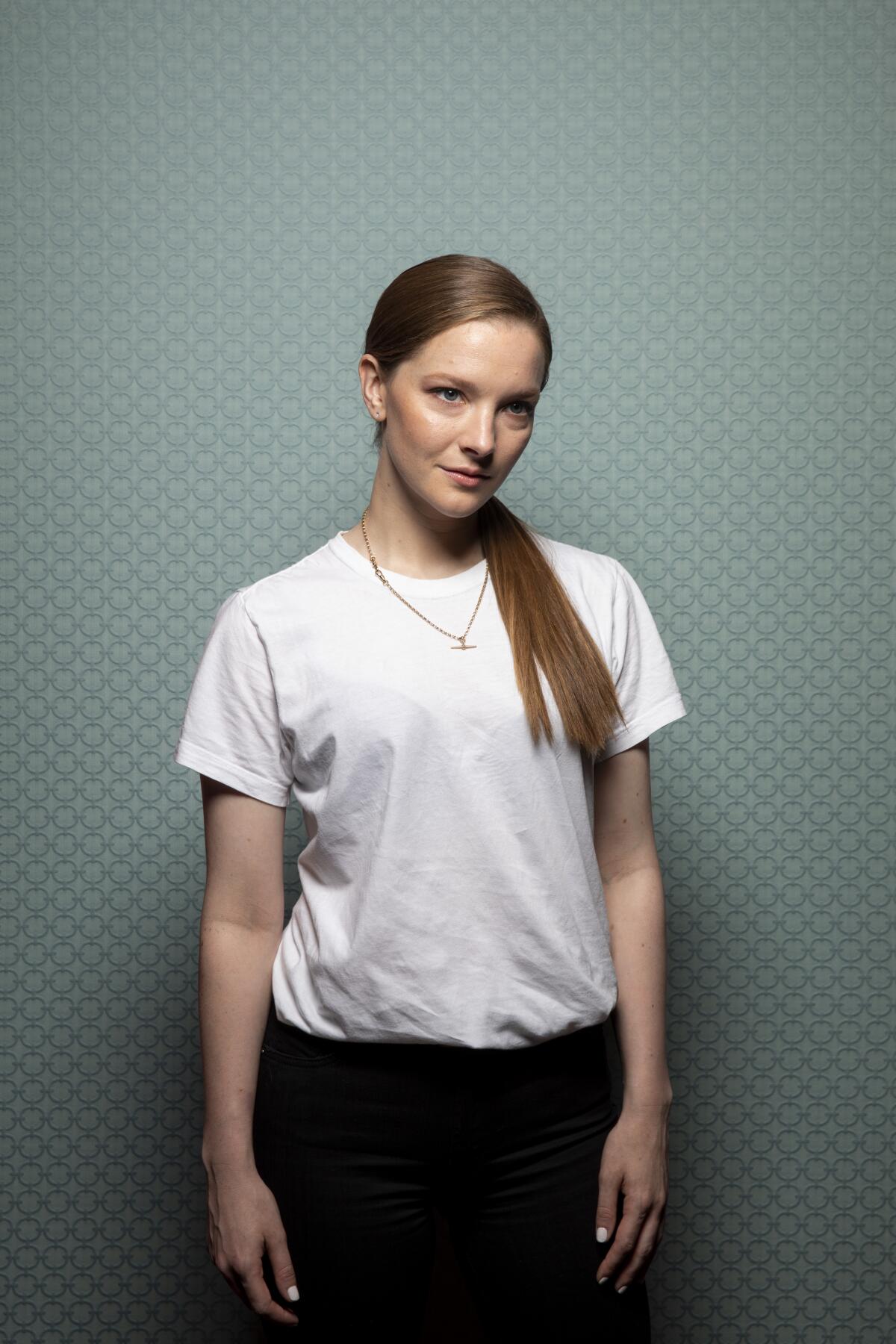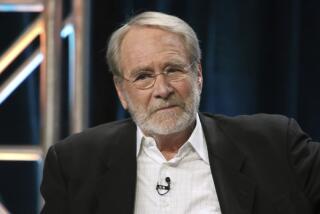Rose Glass examines the private horror of mental illness in ‘Saint Maud’
LONDON — Writer-director Rose Glass has been living with her debut feature, “Saint Maud,” for over six years, more if you add the yearlong delay the film has seen thanks to the pandemic (the film opened in the U.S. in theaters and drive-ins Jan. 29 and is now available on Epix). The tightly wound story of a hospice nurse named Maud whose newly found religious faith takes her to horrific extremes had been percolating in Glass’ head for even longer, drawn from both her Catholic school upbringing and her interest in how our internal worlds can be so vastly different from what we present externally.
“I find that gap really interesting,” explained Glass, speaking in London last March before the film’s U.S. release date was pushed back several times. “What I’ve always really liked about cinema is how, maybe more than any other medium, it allows you to put yourself into someone else’s head. I knew for my first film I wanted to do something very subjective.”
Glass began writing the script after graduating from Britain’s National Film & Television School in 2014, building the idea in her spare time and eventually bringing it to broadcaster Film4, who put the story into development in 2016. Glass had made several narrative and experimental shorts previously, and grew up admiring filmmakers including David Cronenberg, John Waters and David Lynch, who make movies that “lean into the weird and psychological.” At first, she imagined “Saint Maud” as a two-hander between Maud and God.
“As I started picking apart the story, I started to wonder what was going on in Maud’s life and why her main relationship was with this voice in her head,” noted Glass, who sees the film as a “weird” horror movie. “It developed from there.”
Casting director Kharmel Cochrane, who had done “The Witch” and “The Lighthouse,” brought Welsh actress Morfydd Clark in to audition in early 2018, before Glass had even completed the script. Glass and her producers were aware that the film’s success or failure hinged on whether they could find the right Maud, and casting Clark immediately felt inevitable.
“I could see [Maud] so clearly,” Clark said via telephone last month from New Zealand, where she is shooting the “Lord of the Rings” TV series. The character has mysteriously left her job in a hospital to care for a dying former dancer named Amanda (Jennifer Ehle) in a decrepit seaside town in England. She’s an isolated woman who only becomes more so as she descends into a madness she mistakes for devotion, taking her faith to deeply unsettling and self-destructive places.
“She made so much sense to me,” Clark added. “The script was highlighting things that, if I had the ability to write, I’d want to highlight. You often read really good things, but it doesn’t always feel as personal to you. I’ve grown up with half of my family being quite religious, quite Catholic, and I’m not. I’ve always thought, ‘What if I suddenly believed in God?’ ”

Glass, at the suggestion of Cochrane, offered Ehle the role of Amanda without even meeting the U.S.-born performer (Ehle is the daughter of British actor Rosemary Harris and American writer John Ehle). She had originally written Amanda as an older British woman, but the idea of bringing Maud and Amanda closer in age was appealing and served to further highlight how the two very different women were both grappling with loneliness and a desire to escape reality.
“Each of them misguidedly thinks they can help the other, and they just both completely misunderstand each other,” Glass explained. “We’re all living in the same real world but subjectively experiencing it through these fleshy bodies we’re stuck [in] and these brains we have.”
“We don’t get an opportunity to see [two women] occupying the screen together like that very often,” said Ehle last month from New York. The actor arrived only three days before production and went straight from the airport to her bald-cap fitting. “To talk to a director who’s interested in seeing that and exploring that, together with this script, gave us so many possibilities. They’re just two very interesting women who are extremely different, and the dynamic seemed like it had a lot of potential. And it’s wonderful to play a woman who doesn’t have to behave.”
The film was shot for five weeks at the end of 2018, with the interiors done in London and the exteriors filmed in the northern English coastal town of Scarborough. Although it’s set in present day, the stark aesthetic, amplified by cinematographer Ben Fordesman (also making his feature debut), feels timeless, with inspiration taken from classics like Ingmar Bergman’s “Persona” and “Through a Glass Darkly.” The team used as many practical effects as possible, and all of the scenes with stunts or VFX were carefully storyboarded.
“The look and feel of the world was something I was very specific about,” Glass said. “Even before I finished the script, I was collecting mood boards. Because of the kind of films I like and the sort of tension and atmosphere I wanted to achieve, you need a lot of planning. One thing we tried to do was make the visual style of the film gradually become more and more exaggerated and stylized as she descends into madness. It is this intimate, personal story, but we wanted to tell it on an epic, cinematic scale.”
She added, “The tone of it was one of the things I was most aware of trying to get right. It could so easily descend into too melodramatic or just ridiculous. Both [Clark and Ehle] are very effortless actors, so even though I had them doing all this bonkers stuff, they managed to ground it in very human, relatable emotions.”
Glass continued sculpting the story through the six-week edit, during which she wrote additional scenes and decided to shoot five additional days. She recognized that, although planning was essential to getting the film right, there had to be some flexibility both on set and during postproduction to ensure everything felt as fleshed out as possible.
“I think during the writing I got so uptight and stressed and nervous and was dreading it at a certain point,” the director reflected. “You want to control every moment of it. You get quite obsessed about it. But by the time I got to shoot, I’d been through this prep and suddenly I had all these other people working on it and it all felt so much more real. I was able to let go of stuff. You have to keep responding to the thing you’re actually making in front of you.”
Both Clark and Ehle emphasized how much control Glass had of her vision, without being controlling.
“I really like working with people who don’t have a lot of other people’s expectations riding on their work,” said Ehle, who had no trepidation coming on board a first-time director’s film. “I like working with people who can do what they want to do and make what they want to make. And to do that, you can be with somebody doing their first film or you can be with a filmmaker like [Steven] Soderbergh or [Kathryn] Bigelow. Those are the times when it’s really fun to serve somebody’s vision.”
Although “Saint Maud” reflects on faith, in this case Christian faith, it’s not necessarily a rumination on religion. It grapples with mental health — Maud is clearly undiagnosed with several conditions — and it asks why a woman might go to such lengths to submit herself to a higher power.
“I never was interested in it being a story about her being led astray by a community of fellow believers or anything like that,” Glass explained. “It’s a completely private thing [for her], and it’s obvious that she’s creating her own warped version of Christianity. Life is messy and complicated and chaotic, and it’s easily understandable why people look to all sorts of thing — religion being one — to try to make sense of the world and their place in it. It’s looking at the dangers of when somebody becomes so alienated from the rest of the world and the rest of society and feels undervalued and how you can turn to extremes.”
“I actually found it surprisingly easy to get in Maud’s head,” Clark said. “I don’t know if that’s a problem with me or if it’s the wonder of Rose’s writing or both. We all have the capacity to be our own version of Maud. It’s by the grace of God, or the grace of the welfare state, that more of us aren’t there. I didn’t feel she was as far away as she may seem to some people.”

Glass spent the past year co-writing a new film with her National Film & Television School classmate Weronika Tofilska, which they hope to get to shoot this year, but “Maud” has lingered. The film had a short theatrical release in the U.K. in October before the country went back into lockdown (it previously played at the Toronto and London film festivals in 2019). It’s been delayed in the U.S. so many times that Glass can barely keep track, leaving her unable to consider the film’s opening with any real perspective.
“Releasing your first film is pretty crazy anyway, and then everything else has happened,” she said in a follow-up last month. Because it was so close to going ahead this time last year it felt really big and nerve-wracking, but everything pretty quickly paled in comparison next to all this stuff happening in the world. I’m sure it would be weird anyway, but I don’t have anything to gauge it by.”
“I’ve found now [the film] seems to matter more than ever,” Clark said, “in terms of the conversations around mental health and around health workers. I’ve been thinking about Maud a lot amongst all of this.”
More to Read
Only good movies
Get the Indie Focus newsletter, Mark Olsen's weekly guide to the world of cinema.
You may occasionally receive promotional content from the Los Angeles Times.










